Relaxing at home with noisy neighbors or loud music from upstairs can be hard. However, there are ceiling soundproofing solutions that can help enhance your environment and your life satisfaction.
Whether you’re living in an apartment or a multi-level home, soundproofing ceilings are ESSENTIAL.
This article discusses how to soundproof a ceiling and different types of ceiling soundproofing that can help you.
What Are the 2 Different Types of Ceilings to Soundproof?
Before starting your project, you need to know the different ceiling types. Learn what kind of ceiling you have to find the best method for you.
Drywall Ceiling Soundproofing
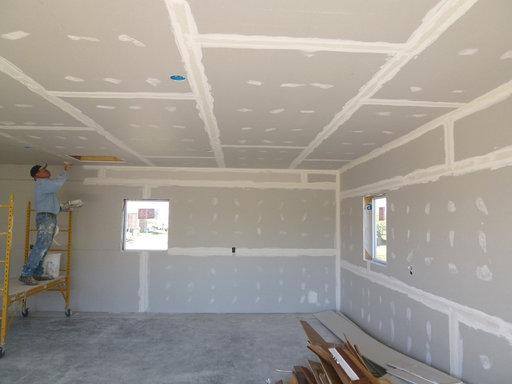
A drywall ceiling comprises gypsum plaster and fiberglass, widely used for ceilings and interior walls.
It’s a durable material ideal for soundproofing rooms to block out unwanted noise.
Many products have vibration isolation systems that suspend the ceiling over isolators. There’s no material making direct contact with the ceiling.
Sound cannot travel because there are no pathways to pass through, which reduces airborne and impact noise.
Another method to soundproof a drywall ceiling is replacing ceiling tiles with ACOUSTIC TILES.
Suspended Ceiling Soundproofing
Suspended ceilings, also known as drop ceilings, hang below the main ceiling and are intended to hide building infrastructures like wiring and ductwork.
A drop ceiling is generally considered to be easier to install and maintain. The gap between the main and drop ceiling allows access for repairs.
You can also replace ceiling tiles with acoustic tiles to soundproof suspended ceilings.
Acoustic ceiling tiles are installed on a metal grid made of fiberglass and coated with mass-loaded vinyl (MVL) to eliminate noise.
What Are the Elements of Soundproofing?
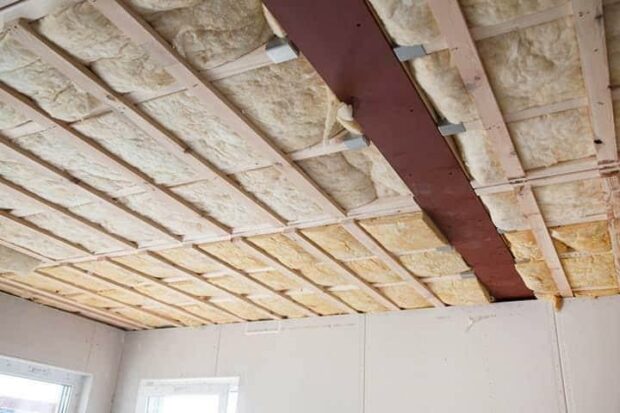
Soundproofing reduces sound transfer from the sender to the receiver by using barriers to dampen and absorb sound waves.
Soundproofing is done to reduce airborne noise and impact noise. Below are its essential components:
Absorption
Sound absorption is when an object absorbs the sound waves that bounce off it, which results in noise reduction.
Soundproofing ceilings are done by filling the ceiling space with insulating material. Insulation is an effective way in reducing sound.
Insulating materials are meant to keep the density of the ceiling LOW to reduce airborne noise.
Common sound insulation materials include:
- Cellulose
- Fiberglass
- Foam
- Recycled wool
- Open cell wool
- Mineral wool
Decoupling
Decoupling refers to the separation of the floor and ceiling to prevent sound transfer.
Because sound is a vibration that propagates as waves, it needs a conductor or medium to be heard.
With ceiling soundproofing, the medium is the joists or studs.
Decoupling is meant to disrupt sound waves by creating a gap between the frames of the ceiling and floor joists.
Drop ceilings are already decoupled by default, as there is already space between the structural ceiling and the drop ceiling.
Decoupling can be done through different methods, namely:
- Resilience channels – The drywall is attached to metal bars instead of joists to reduce vibration.
- Sound isolation clips – These are attached to the ceiling joists, separating them from the drywall ceiling.
Damping
A damping compound cancels noise by transforming sound into heat energy, eventually dissipating.
To enhance sound blocking, use noise reduction products such as:
- Green glue compound – This visco-elastic compound increases the capacity of ceilings to dampen sound. It works best by applying it between two layers of drywall.
- Mass-loaded vinyl – This product consists of a vinyl sheet made of metal particles. Add mass-loaded vinyl to effectively soundproof ceilings.
Mass
Adding mass is another way to reduce unwanted noise.
As sound passes through more materials, more sound is absorbed, making it less likely to diffuse.
Ceiling products and acoustic ceiling tiles are commonly used to increase absorption mass.
Using a soundproof drywall made of dense materials is a good way to reduce airborne sound. It’s made out of gypsum panels with an internal barrier.
How to Soundproof Ceiling Tiles in 7 Ways
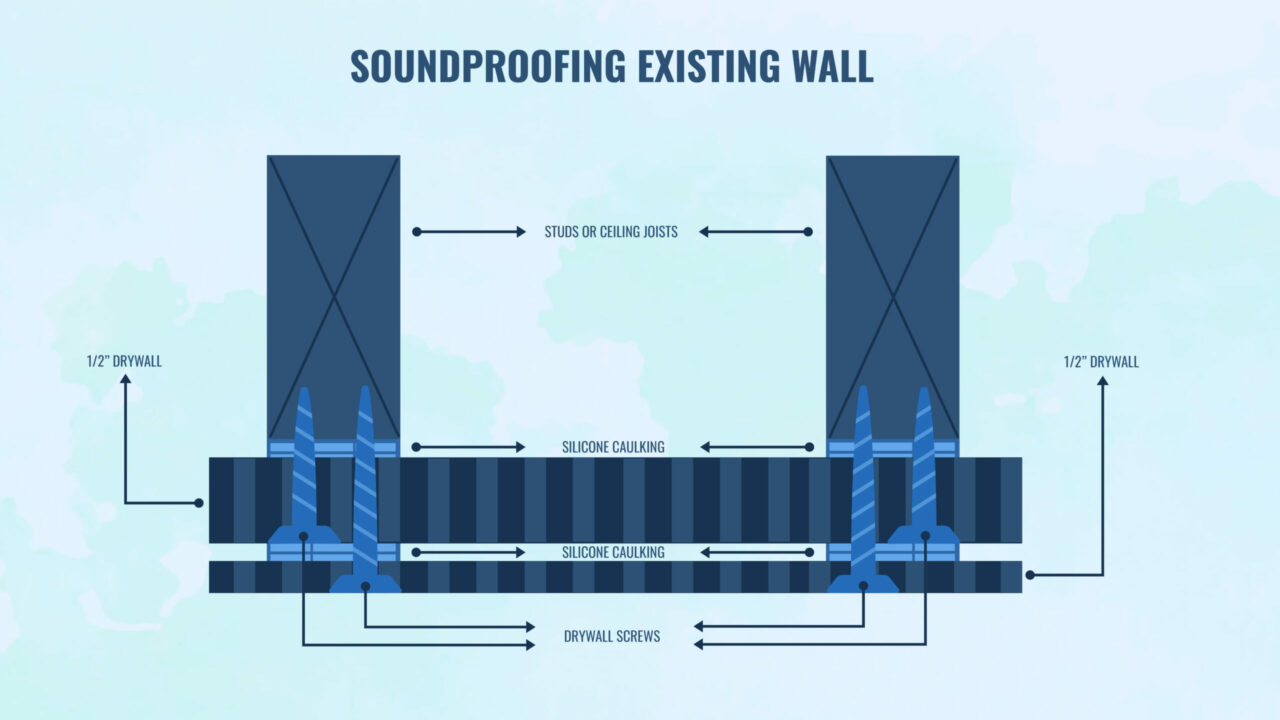
There are several ways to soundproof ceilings. You’ll need to combine different methods to get the best results.
Single Layer Drywall
A single-layer drywall is made of a light panel that is easy for sound to penetrate. It is NOT considered an effective method to block airborne or impact noise.
Using soundproof drywall provides better sound blocking than standard drywall.
However, this drywall can cost up to $40 per sheet. Because it’s so expensive, it’s not a popular choice for many.
To improve standard ceilings, you can fill your ceiling space with sound insulation materials like fiberglass or mineral wool.
This option is effective against airborne noise but not so much impact noise.
Double Layer Drywall
A double-layer drywall is a dense structure made of fiberglass with two layers of drywall.
This setup uses increased mass to make the ceiling more compact.
Due to its thicker layers, it can effectively reduce airborne sounds and even impact noise to some extent.
Double Compound
You can also use Green glue compound to further enhance your double-layer drywall.
Apply a layer of Green glue-damping compound between the double drywall to further block airborne noise.
You do NOT need to remove the existing ceiling to do this method. However, if your drywall has no insulation, you should remove it first.
Remove the existing ceilings and put the Green glue compound on the drywall.
Affix the second layer over the first and attach drywall to the underside of the ceiling. Seal the borders with acoustic caulk to fully secure the ceiling.
TIP: You can also add a third drywall with another layer of Green glue compound for more mass and better sound absorption.
Hat Channels and Resilient Soundproof Clips
Decoupling a ceiling involves resilient soundproofing clips and hat channels.
You’ll have to remove the drywall from the existing ceiling with this method.
Attach the sound isolation clips to the hat channels to separate them from the drywall and joists. Use small screws to fasten them 10 inches apart.
Set the smaller flange of the channels pointed to the roof (joists) with the larger end pointed downwards (floor).
Use the sound isolation clips to attach the hat channels. They cause less sound transfer between the drywall and the joists.
Continue this process from one end of the ceiling up to the other end. Lift the hat channel over any light fixtures.
Once you’re done decoupling, attach the prepared double-layer drywall. You now have a soundproof ceiling!
Floating Joists
Floating ceiling joists are another decoupling method you can do to mitigate impact noises.
This setup works best with drywall ceilings (not suspended) because it cannot be arranged alongside duct systems.
You’ll need to install new joists between the existing ceiling joists.
Afterward, place insulation material between joist sets to further reduce impact and airborne noise.
Don’t compress the insulation too much to prevent any disruption to the new joists.
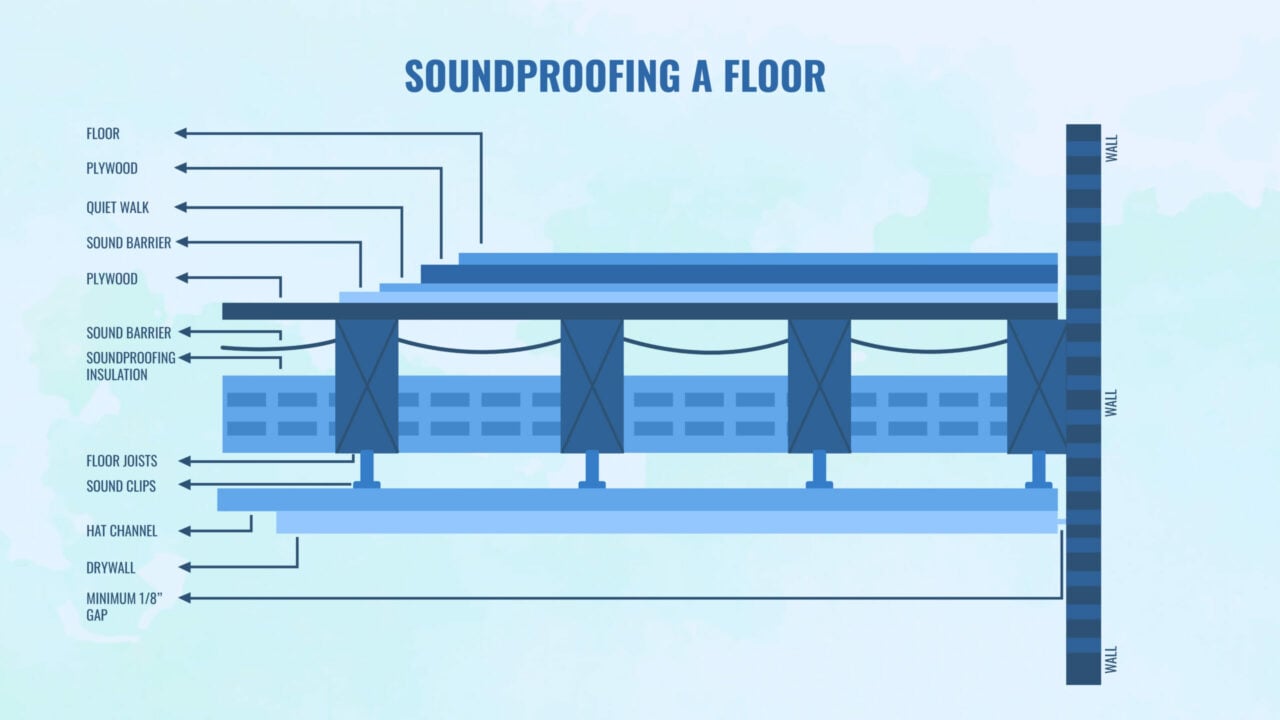
Soundproofing the Floor Above
This soundproof method works on the floor ABOVE the ceiling. It combines insulation, damping, double and single-layer drywalls, and decoupling.
Remove the drywall first to expose the subflooring of the room above.
Take out the subflooring and apply a damping compound. Add more mass by adding another layer of drywall.
Restore the subflooring before placing the double-layer drywall on the ceiling below.
Apply a layer of damping compound in between and decouple the drywall using hat channels.
This method can guarantee a nearly soundproof ceiling with fewer chances of flanking noise.
Adding Underlayment to the Floor Above
If you want to avoid tearing your ceiling apart, you can modify the floor above it.
You’ll only need to remove the existing floor and install an underlayment (e.g., acoustic barrier) to completely block airborne noise and impact noise from the source.
Restore the floor and caulk to seal the perimeter.
This setup is generally inexpensive and works just as well to soundproof a ceiling as other methods.
What Are the Benefits of Ceiling Soundproofing?
Soundproofing ceilings can make a world of difference to your home and comfort. Here are the advantages when you soundproof a ceiling:
1. Reduce Disturbance
Perhaps the most effective advantage of ceiling soundproofing is that it eliminates most, if not all, overhead noise problems.
You wouldn’t have to hear door slams, footfalls, and extra sound that can disrupt your day.
Even if your upstairs neighbors decide to blast music in their room at 1 a.m., your soundproof ceiling can DAMPEN most of the ambient sound.
Alternatively, you won’t have to worry about disturbing anyone should you want to throw a party yourself.
2. Hide Pipes and Ductwork
If you soundproof a ceiling, you also enhance the aesthetics of the room.
You can finally hide the messy clutter of wires and pipes in your basement. The next time you host a get-together, you can be sure your home is flawless.
It’s also easier to style and remodel, so you won’t have to spend on home improvements to get the look you want for any room.
3. Increased Privacy
We all value our privacy. Nobody wants their neighbor, kids, or roommates to hear their conversations.
Airborne sound can travel through open spaces, but soundproof ceiling tiles can absorb sound.
Acoustical ceiling tiles offer soundproofing to keep your conversations away from unwanted listeners.
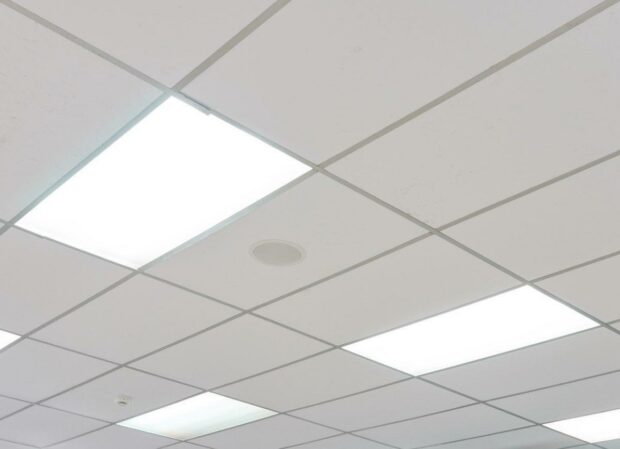
Frequently Asked Questions
Below are related questions about ceiling soundproofing that you might be interested in:
How Much Does it Cost to Soundproof a Ceiling?
On average, the cost to soundproof a ceiling with less than 50 sq. ft. is around $825 in the U.S.
The cost of soundproofing a ceiling largely depends on the soundproof materials, the ceiling area, and the labor cost in your locality.
You can use a wide range of materials for your project to reduce noise.
Acoustic panels cost $18 per panel, while resilient channels can come at $150 per box of 25 gauge.
You also need to check the Ceiling Attenuation Class (CAC) and the Noise Reduction Coefficient (NRC) of the materials you want to use.
They are used to measure the efficiency of a ceiling system.
If you hire a contractor, the project cost will be higher. Estimate the COST of your soundproofing project and plan accordingly.
What Is the Difference Between Soundproofing and Sound Absorption?
Soundproofing is about blocking sound.
Sound absorption uses materials (e.g., wall panels and acoustical ceiling tiles) that can effectively absorb sound from within the room.
Do I Need to Remove My Existing Ceiling When Soundproofing?
No, you DON’T need to remove your ceiling.
To soundproof an existing ceiling, you can attach acoustic panels. If you have a drop ceiling, you can replace the ceiling tiles with sound-blocking tiles.
Conclusion
Soundproofing ceilings are VITAL for any residence or living space.
You don’t have to suffer from unwanted noise such as long showers and loud music when you’re in the comfort of your own home.
Understanding noise and how to reduce its effects can do wonders for your environment and overall comfort.
The method and materials you can use will depend on your needs. Be sure to PLAN accordingly so you can get the best results.


